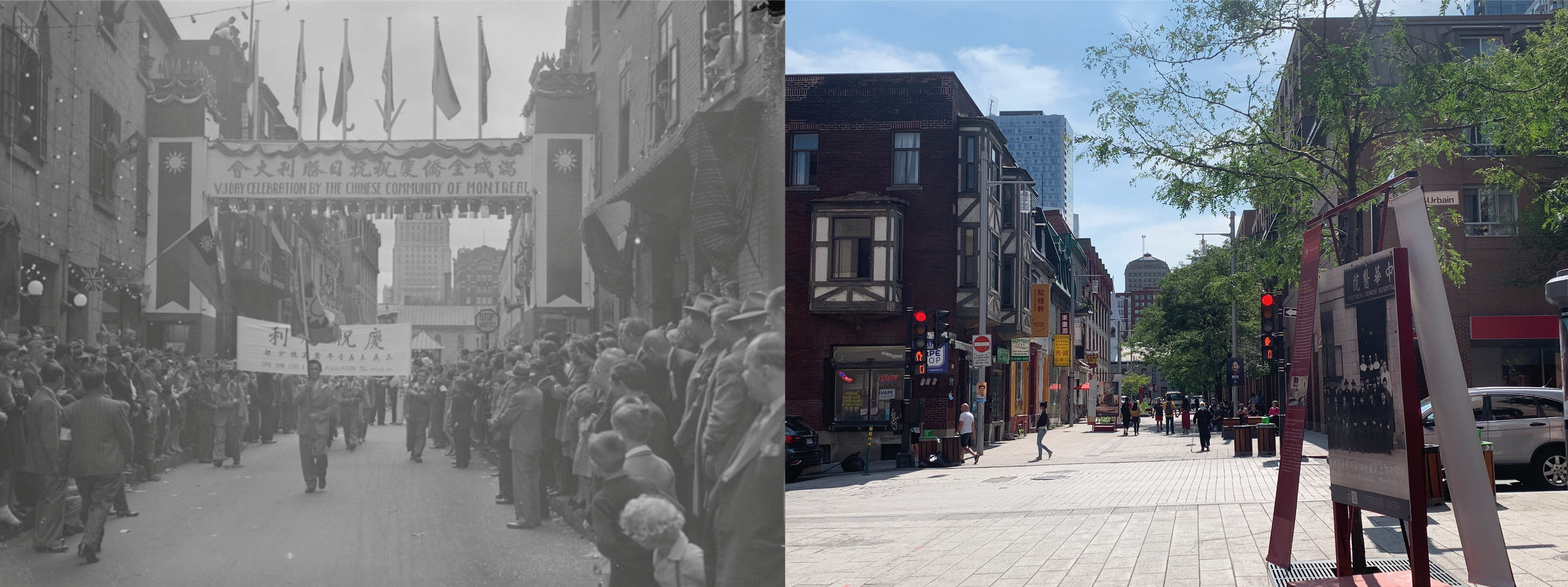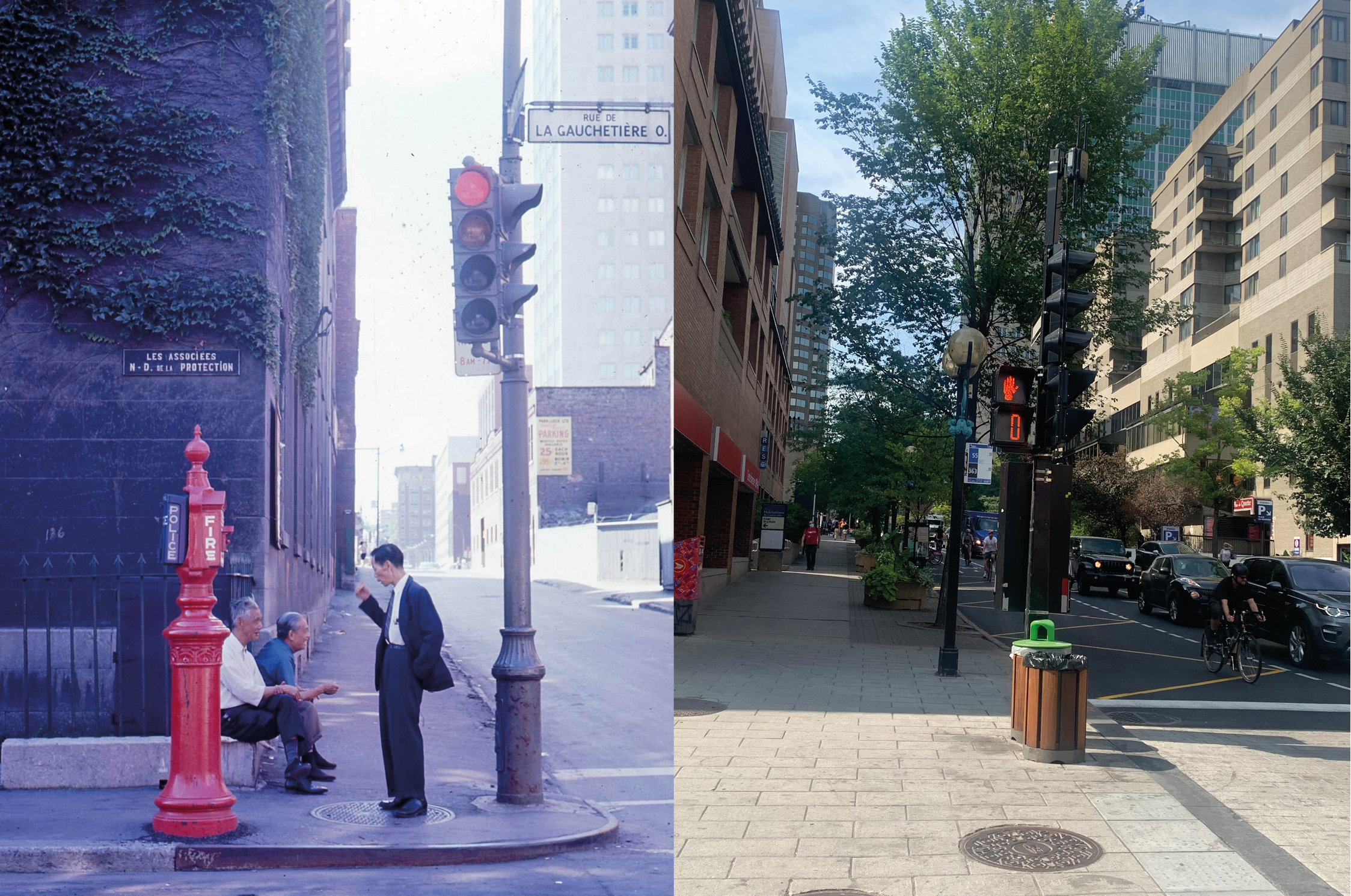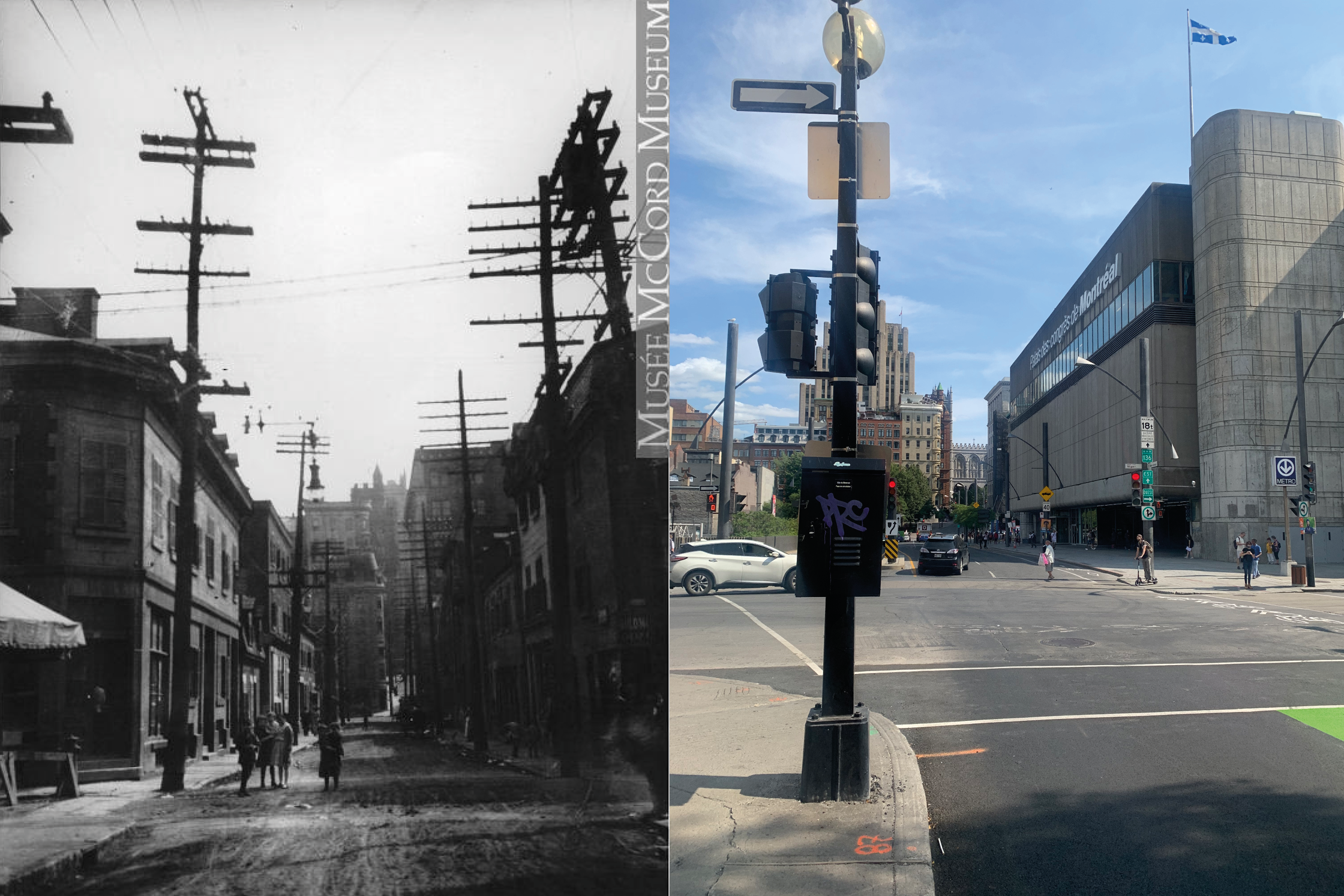
Archival Photo Account
Montreal: Then And Now
Montreal: Then And Now
A collaboration between Elijah Herron and Wawa Li,
A Chinatown Capsule
A Chinatown Capsule
Words by Wawa Li
In collaboration with Elijah Herron
Photos courtesy of Elijah Herron
September 4th 2021
In collaboration with Elijah Herron
Photos courtesy of Elijah Herron
September 4th 2021
In the chinese etymology of the word reporter “记者” [ji zhe], the first character “记” is the verb to remember, to record. The second, “者” is an affix for one person or thing who [does something]. Meaning; journalists or reporters as actors of the memory. In this case, everyone holds the power of journalism. Every day, we contribute to reporting information about our hyper-changing society in our own way.
A cultural and historical site in Quebec, Chinatown harbours many precious memories for migrant families and remains a symbol of resilience for many. Unlike Old Montreal - whose buildings are well-documented and protected from demolition or alteration due to the neighbourhood's heritage status - Chinatown does not have such a classification. Over the past year, communities have mobilized to obtain this consequential designation in light of mounting real estate pressure, with an action plan launched this past spring by the Ville-Marie borough [LINK] to ensure change of course. In cases like this, unearthing memories of Chinatown and reviving archival content celebrating its past take on a brand new weight. Elijah Herron, behind the @montreal.thenandnow project accomplishes this feat by juxtaposing old photographs with contemporary digital pictures, merging past and present in the direction of an optimistic future.
Elijah and I wanted to create a visual-verbal exchange on the subject, using the feeling generated from the pictures as a conversation starting point. Images are rarely innocent records—possessing a power dependent on how they are received and processed and by whom. They also have the power to inspire. A picture, just like a painting, can serve experts, thinkers, innovators, neighbors and you.
A cultural and historical site in Quebec, Chinatown harbours many precious memories for migrant families and remains a symbol of resilience for many. Unlike Old Montreal - whose buildings are well-documented and protected from demolition or alteration due to the neighbourhood's heritage status - Chinatown does not have such a classification. Over the past year, communities have mobilized to obtain this consequential designation in light of mounting real estate pressure, with an action plan launched this past spring by the Ville-Marie borough [LINK] to ensure change of course. In cases like this, unearthing memories of Chinatown and reviving archival content celebrating its past take on a brand new weight. Elijah Herron, behind the @montreal.thenandnow project accomplishes this feat by juxtaposing old photographs with contemporary digital pictures, merging past and present in the direction of an optimistic future.
Elijah and I wanted to create a visual-verbal exchange on the subject, using the feeling generated from the pictures as a conversation starting point. Images are rarely innocent records—possessing a power dependent on how they are received and processed and by whom. They also have the power to inspire. A picture, just like a painting, can serve experts, thinkers, innovators, neighbors and you.










The previous collection of photos focused on the evolution of Montreal’s Chinatown. Each photo set also points to a distinct shift in traditionally immigrant and working class neighbourhoods (like Parc-Extension, the Gay Village, the Portuguese district of the Plateau Mont-Royal, and more). I had the chance to speak with Elijah about the underlying issues affecting these communities, and what the government's role should (and could) look like.
Q : Tell me about your project @montreal.thenandnow
EH: It started in 2017 out of curiosity while I was in urban planning school as I had access to all these archives, photographs, and articles. Something is jarring about seeing these older locations now, places that we go by every day. I think it gives us a moment to stop and reflect on the changes in our city and think about what we want going forward.
There is also something that is triggered emotionally when you see whole areas that have been wiped out. On the West Coast where I grew up, there’s a sense that this has already happened. There’s a similar account initiated in Vancouver—all the small family-run businesses, all gone. As people who live in a city, we have some sort of involvement in that. I remember, growing up, going to some of those spots. I feel like Montreal still has an opportunity to avoid some of that. The project Montreal: Then And Now aims to highlight our historical and emotional involvement in those changes.
Q: How does this look from an urban planning point of view?
EH: A lot of my work is related to “displacement”, where people are being pushed out of the neighbourhood in which they live—farther and farther, kind of “out of sight out of mind”. There's a clear connection between capital coming in where people can buy way above what residents in those neighbourhoods can afford. There are big companies buying multiple residential units then boosting up the prices, and lots of illegal evictions. You often hear about Quebec having great rental protections, but there are a lot of informal and unrecorded evictions happening.
Q: What is at the core of all this?
EH: It’s a very complicated problem with many actors but it comes down to capital.
It’s been going on for awhile but has really been accelerated by the commodification of housing; seeing something as fundamental as shelter being turned into a product to trade. Speculation, or seeing potential value into a place, is a huge driver of gentrification also. What happens is an area is seen as up and coming, and in anticipation of it’s potential, people and companies buy a bunch of properties, flip them and then increase the prices to what they think it should be. All of it is a slow process implying multiple actors. There are so many community networks that get disrupted when housing becomes more about wealth creation than a fundamental necessity.
Q: Who is to blame?
EH: Pressure in activist circles tends to point out the fault on individual tenants, but they are sometimes missing the point. “You didn't refuse the rent increase”, “You didn’t take action against your landlord”. Not everybody has the resources or time to do that. We have to combat a collective capital movement with a collective response, not always individual.
It’s easy to blame a few individuals or big companies for buying all residential buildings, and they certainly are a driver. They are definitely the problem, but the thing with capital is that it also turns community members against each other. Instead of seeing houses as places of interconnectivity between their neighbours, their grocery store or coffee shop, they are seen as investments. This nature of wealth around housing breaks down the community, having impacts on the ways we individually interact.
It’s hard to blame individuals for taking an opportunity that is the best for themselves and their family. Housing is a big sign of intergenerational wealth as well. They are not intentionally trying to harm their community, they are just making a smart decision for their future.
One thing to note is government involvement in this issue. A lot of gentrification and commodification is state sponsored, supported by provincial and municipal governments. Many of these taxes in cities are based on property taxes : the more one pays, the more resources one will get from the government. When the property taxes are increasing, the city is okay with it because they receive this money.
More depressed areas are getting less resources, putting that into this cycle of poverty or prosperity. There are places getting these resources that are disproportionately whiter, richer places, and the people disproportionately affected are people of color or those who don't have as many options. We also see as property taxes go up and other people moving in, long term residents are unable to afford to stay. So the question is: Who is benefiting from these measures? Who is this wealth being created for?
An example in Parc-Extension is this new development supported by the government, the new university campus focusing on science and AI that has little interaction with the communities around it. The provincial and municipal governments are big partners in this development and this will have a huge effect on the neighbourhood. They have been unwilling to negotiate with the community groups to minimize long term displacement or potential harm. Organized community groups in Parc-Ex are trying to negotiate for some benefits and to protect this vulnerable area. This heavily subsidized and government coordinated development has all the power to choose to engage yet is unwilling to. Understanding how the government has a responsibility is an important point as often they work in tandem with private interests to create circumstances. In this example, the government is an active participant, not just neutral.
Q: What can we do, Elijah?
EH: It’s intimidating, but where we can start as individuals and as a community is to reevaluate our relationship with ownership and property in general. There are great examples of small scale community-owned collective properties, like Milton Parc for example. It’s working, it’s not always perfect but at the end of the day, they are still able to control the future of their neighbourhood. There are also innovative initiatives like Brique par Brique and land value taxes that are helping to show alternative ways of approaching property ownership.
Collective actions also lie around a lot of boring policy changes: those land value taxes, having social housing requirements, building social housing. It’s difficult when we are seeing such rapid and violent displacement happening in our cities to want an intense appropriate response, but we have to remember that fundamental change is a long term process also. The commodification and displacement didn't happen overnight either, so changes will take time. It's about being consistent and collective, making sacrifices for a sustainable future, thinking bigger terms even if it seems hard to see these on an individual scale, [especially for those who are hustling to live their lives]. Often it doesn't seem important until it happens to you, but it is happening to you—it’s been happening to you, you just don’t see it.
All this can seem very overwhelming and we can fall into pessimism, but the point is that the changes we see in the photos are part of a process, and happening to us now. We have an opportunity to decide what we want our cities to be and for who.
FURTHER READING
- What a City is For by Matt Hern
- Capital City by Samuel Stein
- The Color of Law: A Forgotten History of How Our Government Segregated America by Richard Rothstein
- How To Kill A City: Gentrification, Inequality and The Fight for The Neighbourhood by P.E. Moskowitz
- Montreal: A Citizen's Guide to City Politics by Eric Shragge, Jason Prince and Mostafa Henaway, eds
ABOUT THE WRITER
Wawa Li is an independent fashion designer and conceptual artist born in South China and raised in Quebec. Initially driven by apocalyptic concerns, she chose to master the discipline of garment at Université-du-Québec-à-Montréal. During her apprenticeship, she was often caught flirting with other weapons as conceptual installations and performance. In times of nature takeover, she seeks honor for her ancestors while questioning ways to extend humanity’s relevance through alternative realities.
Wawa Li is an independent fashion designer and conceptual artist born in South China and raised in Quebec. Initially driven by apocalyptic concerns, she chose to master the discipline of garment at Université-du-Québec-à-Montréal. During her apprenticeship, she was often caught flirting with other weapons as conceptual installations and performance. In times of nature takeover, she seeks honor for her ancestors while questioning ways to extend humanity’s relevance through alternative realities.
ABOUT THE COLLABORATOR
Elijah Herron is an Urban Planning graduate living and working in Montreal for a decade. Originally from Victoria, B.C. he has an interest in the forces that shape our cities, especially the ones leading to displacement and inequity. He also runs the project Montreal Then and Now, highlighting the history and changes of Montreal’s urban fabric.
Elijah Herron is an Urban Planning graduate living and working in Montreal for a decade. Originally from Victoria, B.C. he has an interest in the forces that shape our cities, especially the ones leading to displacement and inequity. He also runs the project Montreal Then and Now, highlighting the history and changes of Montreal’s urban fabric.
- Near Wings (1903-1910), BANQ - Collection Michel Bazinet
- Chinatown Parade, De La Gauchetière (1945), [the Chinese community celebrates Victory Day with a parade through the streets of Chinatown], by Conrad Poirier. National Library and Archives of Quebec. P48, S1, P12333
- Chinatown Parade, De La Gauchetière & St-Urbain (1945), [the Chinese community celebrates Victory Day with a parade through the streets of Chinatown], by Conrad Poirier. National Library and Archives of Quebec. P48, S1, P12333.
- Chinatown Parade, De La Gauchetière (1945), [the Chinese community celebrates Victory Day with a parade through the streets of Chinatown], by Conrad Poirier. National Library and Archives of Quebec. P48, S1, P12333.
- Clark & De La Gauchetière (1969), Montreal Archives
- St-Urbain & Viger (1915), McCord Museum. MP-1978.207.1.6.






